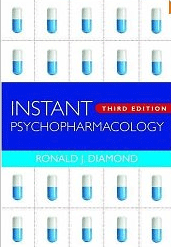Instant Psychopharmacology

“Instant Psychopharmacology”
By Ronald J. Diamond, M.D.
W.W. Norton & Company, Inc.
New York, N.Y., 2009
Medications thoroughly examined in useful book
Reviewed By James K. Luiselli, Ed.D., ABPP, BCBA-D
Mental health professionals who are non-physicians should be knowledgeable about psychotropic medications. Indeed, pharmacotherapy is often used in conjunction with psychosocial intervention. Ronald J. Diamond, M.D. writes that the premise of his book, “is that medications will be most useful if the people taking them and the non-medical clinicians with whom they work know as much as possible about what medications can do to help and what problems medications can cause.”
“Instant Psychopharmacology” opens with a chapter titled, The Rules of the Game. Here, Diamond outlines essential considerations when prescribing psychotropic medications. For example, he comments on drug side-effects, drug-drug interactions and generalized drug influences on mood and behavior. He also advises clinicians about potential obstacles to medication compliance and the importance of comprehensive medication monitoring.
Another introductory chapter covers the basics of psychopharmacology. Diamond gives an overview of medication classifications and then discusses the role of neurotransmitters in mental illness, how medications are absorbed in the bloodstream and the half-life features of different medications. He explains this and related information clearly and at a level that would be comfortable for novice readers.
The bulk of the book contains chapters on four medication classes: antipsychotics, antidepressants, mood stabilizers, and antianxiety medications/sleeping pills. Each chapter is detailed, essentially covering everything you would need to know about specific medications in each class, their intended use, contraindications and metabolic actions. These medication-specific chapters are up-to-date and as inclusive as any I have read in similar books.
The book includes several tables that list medications by their generic name, corresponding brand name and respective therapeutic actions. There are additional tables showing generic-brand name medications by class and the typical daily dose and cost per month. These tables are a handy tool for navigating the vast array of medications that characterize contemporary psychopharmacology.
True to his objectives, Diamond has written a book that will benefit mental health professionals as well as people taking psychotropic medications. He notes that the book can be read cover-to-cover or one can sample individual chapters to learn more about specific drugs. Another noteworthy aspect of the book is the attention it gives to collaborative decision-making between professionals and patients in the course of medication treatment. Reasonably priced and in paperback form, “Instant Psychopharmacology” is a valuable resource you should have in your reference library.
James K. Luiselli, Ed.D., ABPP, BCBA, is senior vice president, applied research, clinical training and peer review at the May Institute in Norwood, Mass.
Learn more about the book: Instant Psychopharmacology (Third Edition)
